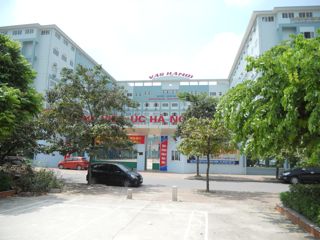 After leaving Shanghai the other day I traveled south to Hanoi, Vietnam. My Sydney school has an “arrangement” with a Vietnamese school here. The school is called the Vietnam Australia School, or VAS Hanoi, and the arrangement is that as well as the school offering a standard Vietnamese curriculum it also offers a scaled down and modified Australian curriculum focusing on English and Commerce. This Australian component is taught by native English-speaking teachers, using courseware and textbooks developed by staff back at PLC Sydney, and the goal is to get the kids leaving school with qualifications in two languages and two countries. I’ve been keen to get to VAS for a while to see what it’s all about, so when I asked my principal for permission to attend Learning 2.010 in Shanghai he suggested that I drop into VAS Hanoi on the way home and do some training and support for the staff here.
After leaving Shanghai the other day I traveled south to Hanoi, Vietnam. My Sydney school has an “arrangement” with a Vietnamese school here. The school is called the Vietnam Australia School, or VAS Hanoi, and the arrangement is that as well as the school offering a standard Vietnamese curriculum it also offers a scaled down and modified Australian curriculum focusing on English and Commerce. This Australian component is taught by native English-speaking teachers, using courseware and textbooks developed by staff back at PLC Sydney, and the goal is to get the kids leaving school with qualifications in two languages and two countries. I’ve been keen to get to VAS for a while to see what it’s all about, so when I asked my principal for permission to attend Learning 2.010 in Shanghai he suggested that I drop into VAS Hanoi on the way home and do some training and support for the staff here.
So for the past few days I’ve been at the school, seeing how it operates, talking to staff, meeting the kids, and generally trying to offer some support where I can. There are certainly places where that support is needed, so it’s rewarding to be able to offer it. Now that I have a clearer understanding of what’s going on here at VAS Hanoi I’d like to visit again at some point to really follow through on a few things. For now though, that’s a decision that’s out of my hands.
I can’t say I’ve fallen in love with Hanoi though. Don’t get me wrong, it has a definite charm, if charm is the right word. Perhaps ‘character’ would be a better word. The city of Hanoi is celebrating its 1000th birthday this year, so although I don’t know much else about its history, 1000 years is a long time, and it’s had plenty of time to cultivate that character. The people are generally friendly, the food is excellent and inexpensive, there’s plenty of interesting culture, and the Vietnamese women are amongst the most beautiful in the world. So what’s not to love?
 While I’m enjoying seeing a new place and experiencing a new culture, there are a few things about Hanoi that I simply couldn’t deal with long term. The obvious one is the traffic. It’s crazy. I mean, seriously crazy. It’s one of those places where people can tell you it’s crazy, but until you see it for yourself you just have no idea. I made a little video below to give you a look at what I mean.
While I’m enjoying seeing a new place and experiencing a new culture, there are a few things about Hanoi that I simply couldn’t deal with long term. The obvious one is the traffic. It’s crazy. I mean, seriously crazy. It’s one of those places where people can tell you it’s crazy, but until you see it for yourself you just have no idea. I made a little video below to give you a look at what I mean.
The traffic also creates another problem… air quality. The pollution from all those millions of bikes is frightening. I’ve had a hacking sore throat from almost the minute I stepped off the plane. At times it’s been hard to speak and hard to swallow, and I really don’t think I could live here for an extended period because if it. In heavy traffic, the swarm of bikes also kick up a cloud of dust that further dirties the air. I just couldn’t live with it long term.
The other thing that tarnished Hanoi a little for me is the fact that my iPhone was stolen the first night I got here. I went for a walk along the streets to do some sightseeing, and a couple of rather pretty local girls pulled up on a motorcycle and asked me if i wanted to go for a ride around the block with them. Naturally I said no… I wouldn’t jump on a bike with total strangers in a city with sane traffic, but especially not in Hanoi! One of the girls was standing next to me, and started to rub me on the arms and shoulders and was trying to convince me to get on the bike, while the other talked to me. I basically said thanks but no thanks, spoke them to them for another minute or so, and then started to walk away. As they rode off, I reached into my pocket to see what time it was, and there was no iPhone in my pocket. I was so pissed off!
Luckily, I’d taken out travel insurance for this trip. I don’t normally take insurance, but it seemed like a good idea for travelling in South East Asia just for the medical coverage so I ticked the box for that option when I booked the plane tickets. I was a little less pissed off when I remembered that I had the insurance because it meant that the phone would probably be replaced, probably with an iPhone 4, so given that the insurance cost me all of $10, I’m very glad I took it out! However, what won’t be replaced is the data added to my phone since the last sync, including a few very special podcast recordings and photos, etc. Gone for good! So annoyed!!!
The insurance company said I needed to fill out a police report before they could process the claim, so I went to the local station, conveniently just across the road from my hotel. What a pack of losers. I’m told there is massive corruption in the police force here, and while I can’t personally vouch for the truth of that, I can certainly say there is massive unprofessionalism. The police on duty were a bunch of slobs; dirty, lazy, slow, unsure about how to fill out a report, and they treated the whole thing as a bit of a joke. They seemed more than a little put out that I was actually making them do some work instead of leaving them alone to sit and watch television. Of course, they didn’t speak a single word of English, so I had to go back across the road and get the hotel concierge to come over and try and translate for me; this seemed to annoy them even more, since when they thought there was a language barrier they figured they could just fob me off. I think the concierge did an ok job of the translation, but really, who would know? Overall though, if that’s the level of service and professionalism you got from official bodies like the police, I could never enjoy living here.
The other big reason I’m probably not enjoying Hanoi as much as I should be is just the fact that I’m on my own here. Shanghai was fun because I had so much to look forward to, meeting people that I was genuinely excited to be hanging out with. When you’re “hangin’ with your peeps” things are always lots more fun. In Hanoi I don’t really know anyone, so it means eating meals on my own, sightseeing on my own, spending time on my own. Not a whole lot of fun really. At this stage I’m just really looking forward to going home to my Linda.
Anyway, here’s a bunch of photos I took on my walk tonight if you’re interested. I took them with the new Nikon S4000 I picked up duty free as I left Sydney airport, and for a camera without any manual controls (and the fact that I didn’t have a tripod with me) they aren’t too bad for night time shots. The traffic is particularly bad because today is the day of the annual Mid-Autumn Festival celebrations, so it’s somewhat crazier than usual!
Oh, and here’s the video…

 Our Year 4 students are doing a unit of work on Australia at the moment, so I started the term by
Our Year 4 students are doing a unit of work on Australia at the moment, so I started the term by 
 Another
Another